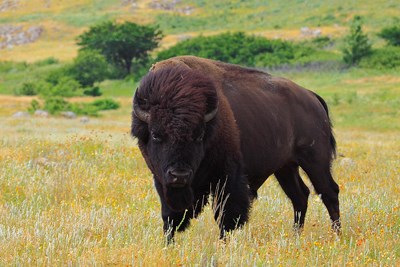Last updated: November 6, 2017
Article
Bison Bellows: Why Manage Ungulates?

Photo courtesy of Randy Jones/US Fish and Wildlife Service.
Today, ungulates occur across roughly 98% of all National Park Service lands. Over the past 100 years of the park service, ungulates have endured a variety of different management techniques. They have been introduced to new places, reintroduced where they originally were, fed, hunted, culled, fenced in and out of parks, euthanized, and given contraceptives. While the list of management techniques may seem to have no strategic direction, every ungulate species is different and serves different natural and cultural roles. Therefore, the management for each ungulate species must be specialized to fit that particular species---bison are ultimately managed differently than elk, bighorn sheep, and feral pigs.
To understand how ungulates fit into the NPS mission, one must first understand their role as a natural resource. It is estimated that there are approximately 220 species of ungulates globally, with 12 native to North America---one of these species being the American bison. Ungulates serve as both the bottom-up tropic driver as well as the main recipient of top-down trophic pressure. In other words, ungulates represent both a prey species for top predators, but also a primary consumer of vegetation. Therefore, management must strive to conserve ungulates' ecological role at a large landscape scale and at different trophic levels. However, only a few NPS units are large enough to integrate large landscape-level processes, so a main challenge is in regards to managing ungulates in smaller parks. It is vital that park managers consider factors such as forage quantity, migration, and population demography in management plans.
In terms of the American bison, NPS recognizes that bison are important both ecologically and culturally. In the 2014 Call to Action, item #26 emphasized returning bison "back home on the range." The call centers on the long-term conservation and restoration of wild bison populations. Therefore, in terms of ungulate management, managers must assess whether management is contributing to the long-term conservation of bison. In some parks, forage quantity is limited, so plans must define desired vegetation conditions and the number of bison that the land can support. Other parks are concerned about diseases such as brucellosis, so managing transmission and the risk of spread is imperative. Also, since some parks are small or surrounded by urban development, population control and seasonal movements must be addressed. Plans must ultimately be adapted and specialized for each park in order to maintain a healthy and viable bison population as well as a healthy ecosystem.
Through partnerships with tribes, federal and state agencies, and private landowners, NPS can work collaboratively to reintroduce and maintain bison on current and new lands. With different stakeholder engagement, new and innovative ideas can be shared to work towards the long-term conservation of bison. NPS is certainly working to incorporate the ecological roles of bison with preserving their cultural significance in a modern world. Bison and ungulate conservation must be forward thinking and adaptive in order to focus on the long-term preservation of the species at a large landscape-level.
